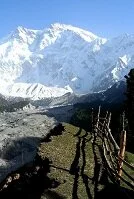Wildlife

Nanga Parbat Mountains
Pakistan is a large country with great geographic variety, making it an ideal home for a large number of animals. Among the large mammal population are lynx, sheep, marmots, bears, wolves, deer, ibex, leopards, boars, rhinoceros, donkeys, gazelles, and numerous smaller mammals like mice and other rodents. One mammal found in the southern rivers is the dolphin, but this is just the start of the country's sea life. The rivers, particularly the Indus River, along with the Arabian Sea are home to thousands of animals. These waters are filled with catfish, shrimp, sharks, and thousands more fish and shellfish.
The bird life in Pakistan is also significant as there are many species that migrate through the region and many more than live there year-round. The pheasant, falcon, culture, pelican, crane, osprey, kingfisher, owls, partridges, and flamingos are all present. There are various reptiles, including turtles, snakes, lizards, and crocodiles and a number of amphibians as well, including numerous frogs.